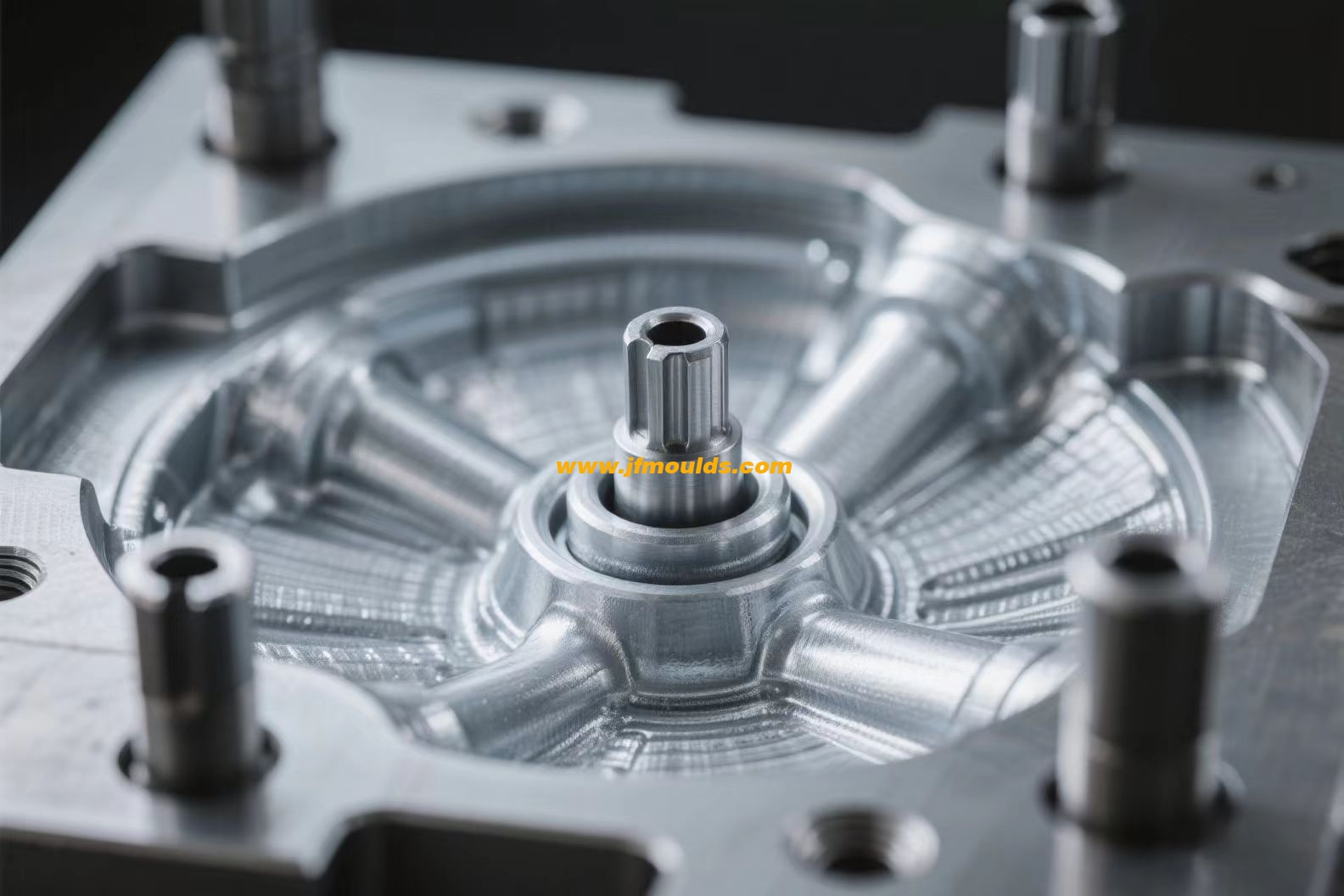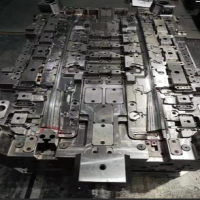Công nghệ cổng khuôn phun
Hệ thống giao phối
Khuôn đúc Ô Tô Công ty TNHH khuôn đúc jiefeng thái Châu (jfmoulds.com)
Khi thiết kế khuôn, việc lựa chọn vị trí cổng và hình thức cổng đóng vai trò quyết định trong nền kinh tế sản xuất đúc phun.
1.1 Hệ thống gating để kết nối các bộ phận đúc phun
1.1.1 Á hậu lạnh
Đối với khuôn chạy lạnh, cả phần đúc phun và cổng được làm mát bên trong khuôn và đồng thời được đẩy ra trong mỗi chu kỳ đúc.
Điểm mấu chốt của thiết kế người chạy lạnh là đảm bảo lấp đầy đồng đều của tất cả các hốc nấm mốc. Do đó, chỉ khi khoảng cách từ tất cả các hốc đến điểm vào keo trung tâm là bằng nhau, quá trình làm đầy mới có thể được đảm bảo là đồng đều.
Nếu diện tích mặt cắt ngang của thanh thức ăn (còn được gọi là cánh tay chạy) quá nhỏ, thì áp suất phun rất cao sẽ được yêu cầu để lấp đầy phần đúc phun. Áp lực tiêm cao có thể gây ra căng thẳng bên trong, dẫn đến nứt sản phẩm.
Một khi áp suất tiêm quá cao, áp suất bên trong khoang cũng sẽ tăng lên. Nếu trợ cấp lực kẹp của máy ép phun là không đủ, phần đúc phun sẽ mở rộng.
Khu vực cắt ngang của kênh chuyển hướng có thể được coi là một chức năng của trọng lượng sản phẩm và giá trị tham chiếu của nó có nguồn gốc từ kinh nghiệm thực tế.
Đường kính của người chạy nên ít nhất là không ít hơn độ dày thành tối đa của phần đúc.

Khuôn đúc hàng hóa Công ty TNHH khuôn đúc jiefeng (jfmoulds.com)
1.1.2 Người chạy khuôn ba tấm
Ưu điểm của khuôn ba tấm là phần đúc phun và người chạy có thể được lấy ra từ hai bề mặt chia tay khác nhau. Điều này làm giảm một bước bổ sung, cụ thể là tách cổng khỏi phần đúc.
Khuôn ba bảng có thể lấp đầy các sản phẩm thông qua một hoặc nhiều lỗ mở. Điều này có nghĩa là có sự tự do lớn hơn trong thiết kế so với khuôn hai tấm. Hệ thống rót khuôn ba tấm được thực hiện bằng các cổng điểm có thể phá vỡ.
Khi khuôn được mở, thanh vẽ hoặc móc vẽ được tiêm khuôn cố định người chạy trên khuôn cố định. Vì vậy, vòi được rút ra khỏi sản phẩm. Có một cơ chế tương tự như chân phun ở phía khuôn cố định để đẩy kênh dòng chảy. Một lợi thế của khuôn ba tấm là khoảng cách giữa các hốc có thể rất nhỏ gọn.
Cần lưu ý rằng diện tích mặt cắt ngang của kênh phân chia cần phù hợp với trọng lượng sản phẩm và kênh phân chia nên được cân bằng. Vì hai bề mặt chia tay cần được mở, một trong những bề mặt có thể bị trì hoãn trong việc mở, chẳng hạn.
Nếu có thể, hãy đợi cho đến khi lõi thoát ra khỏi phần đúc phun hoặc lõi ren được quay và bị hủy trước khi mở nó.
Việc mở ba tấm, cụ thể là mẫu, tấm giữa và tấm phóng, chủ yếu được điều khiển bởi máy ép phun. Khóa bên hoặc thanh kéo xác định đột quỵ. Xi lanh khí nén hoặc thủy lực cũng thường được sử dụng để mở tấm ván. Ưu điểm của chúng là vị trí mở của mỗi tấm có thể được kiểm soát theo thời gian.
Các thanh chạy thường gây ra sự cố sản xuất. Để loại bỏ chúng một cách trơn tru khỏi các phần bị lỗi cổ xưa của khuôn, chúng cần được sử dụng
Thao tác đầu vật liệu. Sau khi lập trình, bàn tay cơ học có thể gửi trực tiếp đầu vật liệu đến máy nghiền.
1.2 Hệ thống gating được giữ lại trong khuôn
1.2.1 Kênh dòng chảy đáng tin cậy
Một khuôn để giữ lại hệ thống gating, với diện tích mặt cắt tương đối dày của kênh dòng chảy, có thể duy trì kênh dòng chảy lõi (ống cách điện)
Trạng thái nóng chảy của nhựa trong khuôn của hệ thống gating lưu giữ; Một loại khác là hệ thống người chạy nóng cần sưởi ấm điện.
Khuôn đơn vịnh trực tiếp bơm các sản phẩm thông qua một người chạy chính, khoang lắng đọng trước hoặc cổng được làm nóng. Một khuôn đa dạng cần một hệ thống gating.
Early molds only used cold runners. Later, a large-capacity gating system formed on the second formwork was added. These channels (also known as "skeletons") remain in the mold. Only thick channels can be insulated, and such molds are called insulated channel molds.
When the mold malfunctions or the material and color are changed, the second template is opened and the runner is removed.
Adiabatic channels are often used for high-speed injection molded parts. The molding cycle of different systems does not exceed 15 seconds.
Typical applications include yogurt cartons, threaded bottle caps, disposable tableware, disposable syringes, pens and planting POTS.
1.2.2 Hot runner
(1) Advantages of hot runners
Hot runner is theoretically an extension of the injection molding unit. It should keep the plastic in the mold cavity in a molten state, guide and heat the molten plastic until it reaches the cavity, while maintaining very little temperature and pressure loss. The hot runner meets the aforementioned requirements.
The greatest advantage of hot runner technology is that there is no waste during the injection molding process and the quality of the injection port is good. There will be no phenomenon of material head sticking together when opening the mold during the production process.
Another advantage is that it is convenient to select the gate position for balanced filling of injection molded parts. Feeding from the center of the bottom of the product is balanced filling, which is suitable for all cylindrical products, such as cups, buckets or similar products.
When the depth of the injection molded part is irregular, all the surfaces of the product can be projected onto a plane, and then another one can be drawn
A circle that accommodates all product areas. If the glue is injected at the center of the circle, it can ensure the balanced filling of the injection molded part.
Eliminating the intermittent runner channels on the parting surface enables the application of brand-new ideas in mold design. The mold can become more compact and the number of cavities can be significantly increased. Molds with 128 or more cavities are not uncommon.
(2) Internal heating type hot runner
Internal heating hot runner molds represent the rise of hot runner technology, but they are rarely used nowadays. One drawback of the internal heating system is that the process of changing colors or materials is very complicated.
The original concept of hot runner technology started from the adiabatic runner concept and developed an internal heat diversion and intake system to prevent plastic solidification in the mold runner. Therefore, the heating system is installed at the center of the diversion channel.
High-temperature raw materials will not overflow from the solidified cold material
It is an important condition for the system's sealing performance. More serious defects will occur during color and material changes. Streaks will appear on injection molded parts because the raw material particles will degrade on the surface of the insulation layer. To avoid these problems, every time the color or material is changed, the entire system needs to be disassembled to remove the raw materials in the distribution pipeline, which is a rather complex process.
The heating system is installed at the center of the flow channel. As a heating element
The simple heating jacket regulates the temperature with the help of sensors. The heating sleeves are almost all self-insulating, so the heat transferred to the mold is very little. This ensures that the thermal expansion is very small, thereby enhancing the sealing capacity of the mold.
Internal heating systems should be given priority for processing semi-crystalline thermoplastics, such as polyethylene (PE), polypropylene (PP), or polyamide(PA).
(3) External heating type hot runner
In the external hot runner, heat is transferred from the outside of the mold to the distributor plate. At this point, the molten plastic in the diversion channel does not come into contact with the heating element.
Wind the heating coil
Most heating elements adopt preformed wound heating coils. First, process grooves on both sides of the diverter plate, then insert the wound heating ring into the grooves, and finally seal it with two-component thermal conductive adhesive. Sometimes, the heating ring is only covered with a thin iron plate. Winding the heating ring can make the heat in the gating system evenly distributed.
Cylindrical heating jacket
As an alternative solution, a simple heating sleeve can be used near the flow channel holes on the split plate. The processing of these holes needs to achieve the best dimensional fit with the heating sleeve to ensure smooth heat transfer.
Simple heating sleeves are usually used in combination with thermal conductive adhesive to ensure good heat conduction and make the replacement of simple heating sleeves more convenient. At present, heating jackets are only used for simple molds.
Thông tin liên quan
Kiểm soát làm mát của khuôn
2025-07-23
Điều khiển làm mát của mốc1. Chức năng của ống làm mát là ...
Từ phát triển tùy chỉnh đến nguồn cung toàn cầu, mở khóa động lực cốt lõi của sản xuất hiện đại
2025-07-19
Từ phát triển tùy chỉnh đến nguồn cung toàn cầu, mở khóa động lực cốt lõi của moder...
Khám phá khuôn phun: phân tích toàn diện từ thiết kế đến ứng dụng
2025-07-08
Khám phá khuôn phun: phân tích toàn diện từ thiết kế đến ứng dụng...
Đặc điểm hiệu suất và tiêu Chí lựa chọn khuôn phun
2025-06-30
Đặc điểm hiệu suất và tiêu Chí lựa chọn của khuôn phun...
Các loại khuôn hai tấm bị hủy bỏ
2025-07-22
Các loại loại mốc hai tấm1.1 Các bộ phận được đúc không có quá nhiều ...
Khuôn phun: Nền tảng chính xác và động cơ đổi mới của sản xuất công nghiệp
2025-07-02
Khuôn phun: Nền tảng chính xác và động cơ đổi mới của công nghiệp ma...





